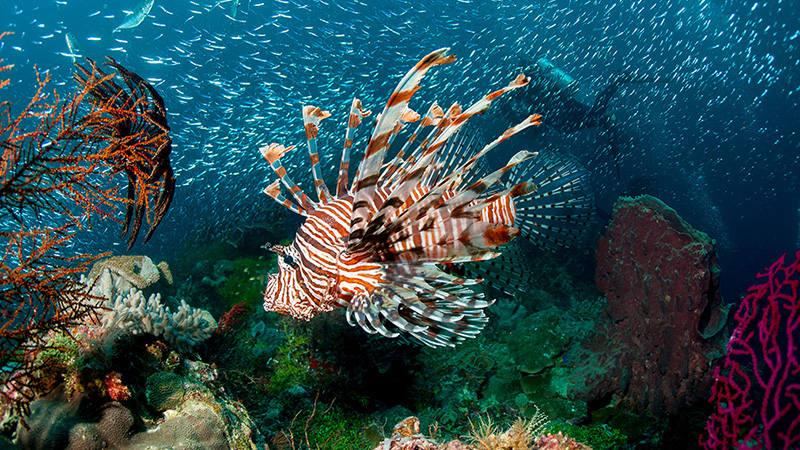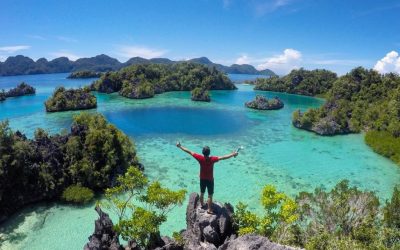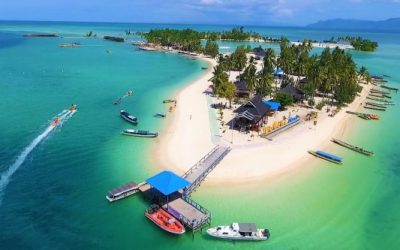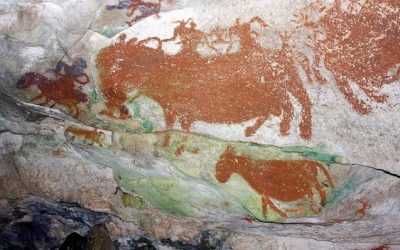Home / Batik Regions – Central Indonesia – Sulawesi Island – Southeast Sulawesi / Wakatobi – UNESCO Biosphere Marine Reserve
Natural Destination
Experience the tropical nature!
Wakatobi – UNESCO Biosphere Marine Reserve
Wakatobi Marine Park (Photo: @PIDII.info)
Wangi-Wangi island as part of Wakatobi Special Region (Photo: @Wisata Sulawesi Tenggara)
Wakatobi – UNESCO Biosphere Marine Reserve
If you are a water sport lover, or you would really like to have a look at how is life going under the sea, then you cannot miss this wonderful underwater tour in Wakatobi. Wakatobi is the acronym of several islands: Wangi-wangi, Kaledupa, Tomia, dan Binongko. Wakatobi National Park is Marine paradise where you can find numerous nautical creatures, such as the Napoleon Fish and beautiful reefs. Possessing rich natural resources, coastal forests and Marine Park, Wakatobi was designated as UNESCO Biosphere Reserve since 2012 and as Indonesian Special Economic Zone for Tourism since 2015.
Natural Tourism Destination
Wakatobi – UNESCO Biosphere Marine Reserve
Tourist Attractions in Southeast Sulawesi
Labengki Island – Giant Clam Marine Reserve
No one knows that the second biggest Kima giant clam (Tridacna gigas) with the size of 50 cm can be found in
Bajo Coastal Village in Bokori Island
Located not far from Kendari City, this small island with white sand is a-must-visit in
Kobori Cave
According to history, the marvelous Megalithic Kobori Cave has existed since 4000 B.C.
Southeast Sulawesi
Batik Motifs
Wakatobi
It symbolizes the coastal beauty of the Wakatobi island and the symbol of Patra symbolizes
Pati-Pati Pinehiku
It symbolizes the hierarchy in society and the social status of the Mekongga
Ake Patra
Ake is related to the divinity and the composition of the universe. It is a symbol of
Discover
Indonesian
Batik
Motifs
Parang Seling
Parang Seling or “alternating daggers” is a royal batik motif. It is a feminine variant of
Bintik Tujuh
The Bintik Tujuh (Seven Dots) motif has 7 white spots and green color gradation as
Wakatobi
It symbolizes the coastal beauty of the Wakatobi island and the symbol of Patra symbolizes
Gonggong Beruntun
This motif illustrates that a person should maintain a positive attitude and
Tabir Tanjung
Tanjung flower is a type of Cherry tree flower, which is commonly found in
Lontara
The Lontara script itself is a typical ancient script of Bugis and Makassar communities. History records that
Gonggong Siput
Gonggong (Strombus Turturella) is one type of sea snail found around
Pucuk Rebung Riau
Pucuk Rebung symbolizes heart determination in achieving goals, good luck, and
Ukir Sentani
The Ukir motif is a batik motif that is inspired by various traditional Sentani wood carvings
Tangerang Herang
Tangerang Herang motif is a symbol of Tangerang city. The Tangerang Herang batik motif consists of
Kasih Tak Sampai
‘Kasih Tak Sampai’ is an idiom in the Indonesian language which refers to
Karawo Mahkuta
Mahkuta refers to Gorontalo’s traditional crown. It represents noble characters of
Cengkeh
The clove flower motif is the main commodity of the Tolitoli Regency. This motif represents
Kain Cual
Cual textile tradition has existed since the 17th century. The word “Cual” refers to
Kaganga Tanah Rejang
If Batik Besurek combines Arabic calligraphy motifs, then the Kaganga batik takes
Mahkota Siger
Siger is the crown of a noblewoman in ancient time. It is a symbol of femininity, strength, and
Leuit Sijimat
This motif reflects the daily activities of the Baduy tribe in Banten. The main ornaments of batik motif consist of:
Gurdo Solo
Gurdo or garuda bird is the mount of the Indian god Vishnu. As the Sun Bird,
Gumin Tambun
Based on Hindu mythology, this motif symbolizes lucks, abundant wealth, and
Bale Lumbu
This motif signifies the welfare of the ancient Sasak society. Bale also symbolizes the
Tampuk Manggis Sasirangan
The motif illustrates the philosophy of the mangosteen fruit, which is
Keluak Daun Pakis
The word “Keluak” is a Minang language which means twisted or tangled. The Motif of
Tenun Bima
The motifs are adopted from Bima woven textile. This pattern has received a great
Taiganja
Taiganja is a precious gold pendant that shows the social status of the Kaili family. It is
Lipaq Sabe
Lipaq Saqbe contains a simple geometric classical motif with various flower decorations. This textile is
Tanah Liek
The word “Tanah Liek” refers to clay in Minang language. It is also known as
Tengkawang Ampiek
With its many advantages, the Dayaks use this leaf in ritual ceremonies. This plant is a symbol of
Sandeq
Sandeq Boat is a symbol of the maritime importance of the West Sulawesi region. The greatness of
Hiu Taliyasan
Indonesia is also home to the world’s largest fish, the whale shark (Rhincodon typus). Hiu Taliyasan refers to
Dayak Taghol
Dayak Taghol has a distinctive style of four curved lines and small dots. This motif represents
La Galigo
La Galigo is a literary work of the Buginese Epic that has 300 thousand epic lines. It is considered even
Besurek Rembulan
This batik illustrates praise for God who created the wonderful universe
Tubo Kelapa
Coconut tree is a symbol of a good character and strong mentality. It illustrates the more success a person, the more
Raja Ampat
Raja Ampat motif represents the marine life at Raja Ampat archipelago in
Pala Salawaku
This motif illustrates the unique weapons of the Maluku region, namely
Bomba Mawar
This motif means sacred love for family, kingdom, and God; It also illustrates
Parang Rusak
Another meaning behind this motif is an unconquerable spirit, symbolized by
Rangkiang
The word “Rangkiang” refers to the rice granary in the Minangkabau language. It symbolizes
Gajah Way Kambas
The motif illustrates the Lampung’s natural reserve, the Way Kambas. it also symbolizes
Biji Kopi
The coffee seeds motif illustrates the pride of local coffee specialities in
Ake Patra
Ake is related to the divinity and the composition of the universe. It is a symbol of
Gedhog Kembang Waluh
a combination of Javanese cultural motif of the Majapahit kingdom (XII-XIV century) with
Kawung
The Kawung motif was created by Sultan Agung Hanyokrokusumo (1593 – 1645) as a symbolic gift for
Buketan Bali
The Balinese bouquet (Buketan Bali) is a floral arrangement and the name is
Sekar Jati
Sekar means flower and Jati refers to teak trees that symbolizes a strong mental character that
Besurek Rafflesia
The term “Basurek” refers to a textile that contains letters or inscriptions
Desa Na Tolu
The Desa Na Tolu characteristic pattern symbolizes the Batak philosophy of existence and
Jumputan Bintang
The word Jumputan means the tie-dye technique, while the word “Bintang” refers to
Enggang Dayak
Local people beliefs that hornbills are an incarnation of the Commander of the Birds. It has supernatural
Insang Ikan
Insang refers to the gills of the fish. This is a typical pattern of Malay ethnic who inhabits
Honai
The Honai is inspired by the traditional house of the Papuan community living in
Daun Sirih
This motif illustrates betel leaves that are used by Lombok communities as traditional
Tongkonan
Toraja’s traditional house is called Tongkonan. Tongkonan is a place for
Kaharingan
The Kaharingan or ‘tree of life’ based on the Dayak tribes’ belief system. This tree symbolizes
Sekomandi
Its philosophical meaning is the eternal union which refers to a saying “until death do us part”
Pattimura
Pattimura is the name of an Indonesian hero who fought against colonialism in
Sero Tangga
The Sero Tangga illustrates an endearing feeling and sacrifices of a person to fulfil
Manguni Minahasa
Manguni is identified as the symbol of the Minahasa people. Manguni is known as a
Gorga Simeol-Meol
The Gorga Simeol-meol is a pattern of plant tendrils. it is regarded as a symbol of longevity and
Burung Bidadari
Bidadari birds are endemic birds in Halmahera. This motif represents an
Bultiya
The word ‘Bultiya’ is an acronym of the three major tribes in North Kalimantan, namely
Tikar Natuna
The Tikar Natuna motif is adapted from the traditional making of pandanus mats in
Sido Mulyo
Sidomulyo is one of the classical motifs, which is specifically used for the bride’s costume in
Gamolan
This motif illustrates Gamolan, a bamboo musical instrument of Lampung that is
Dayak Kamang
Kamang motif is generally found in the Dayak tribe shield because it is believed to
Malinau Cultural Festival
You will witness a unique competition that might not be found other than in
Paqbarre Allo
The word “Barre” means round and “Allo” means the sunlight. This motif is interpreted as
Bekantan Pakis
This motif represents Pakis Haji (Polystichum setiferum), an endemic plant in
Lok Baintan Floating Market
As you can imagine, the most authentic thing is that you can buy things and even
Tifa Totobuang
The batik motifs illustrate Maluku’s traditional music instrument called
Karawo Pinang
Pinang refers to the Palm areca tree. This motif is considered as the original





